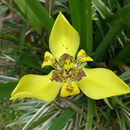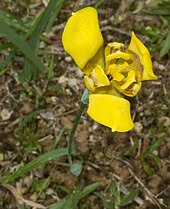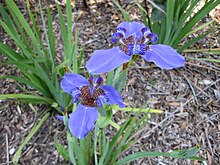zh-TW
在導航的名稱


Neomarica és un gènere de plantes rizomatoses que pertany a la família de les iridàcies. Comprèn 28 espècies nadiues de regions tropicals i subtropicals d'Amèrica Central i Amèrica del Sud.
Són plantes herbàcies perennes que es propaguen per rizomes a través de tanys. Les fulles són molt semblants a les d' Iris i mesuren de 30 a 60 cm de llarg per 1 a 4 cm d'ample segons l'espècie considerada. Produeixen atractives flors fragants que es marceixen ràpidament.
La forma dels escaps florals és molt semblant a la de les fulles normals. Després de florir, un rebrot es comença a formar en l'extremitat de l'escap, el qual continua creixent en longitud. El pes del tany en desenvolupar fa que l'escap s'inclini cap a terra, permetent que la nova planta s'arreli lluny de la planta mare. Per aquesta raó moltes d'aquestes espècies són conegudes popularment com a «iris caminants».
La majories de les espècies d'aquest gènere necessiten condicions càlides i alta humitat per prosperar. Diverses espècies de Neomarica (N. northiana, N. longifolia i N. caerulea) són plantes ornamentals bastant comuns i de fàcil cultiu.
A data de 2012[update], el World Checklist of Selected Plant Families accepta 28 espècies de Neomarica.[2]
Neomarica és un gènere de plantes rizomatoses que pertany a la família de les iridàcies. Comprèn 28 espècies nadiues de regions tropicals i subtropicals d'Amèrica Central i Amèrica del Sud.
Ko e ʻaposetolohina ko e fuʻu ʻakau siʻi ia, manakoa ʻi he ngoue. Naʻe ʻomi ki Tongá ni ʻikai fuoloa. Ko e matalaʻiʻakau ʻene lahi ko e sm. ʻe 5 pē, mo e mata (stigma) lōua ʻi loto. ʻOku ui foki ko e Marica gracilis
http://cookislands.bishopmuseum.org/species.asp?id=6428
Ko e ʻaposetolohina ko e fuʻu ʻakau siʻi ia, manakoa ʻi he ngoue. Naʻe ʻomi ki Tongá ni ʻikai fuoloa. Ko e matalaʻiʻakau ʻene lahi ko e sm. ʻe 5 pē, mo e mata (stigma) lōua ʻi loto. ʻOku ui foki ko e Marica gracilis


Trimezia is a genus of flowering plants in the family Iridaceae, native to the warmer parts of southern Mexico, Central America, South America, Florida, and the West Indies.[2] Trimezia is placed in the tribe Trimezieae. The division of the tribe into genera has varied considerably. In one approach, it contains only the genus Trimezia, which then includes the genera Neomarica, Pseudotrimezia and Pseudiris. In other approaches, two to five genera are recognized, sometimes also including the genus Deluciris.
The English names walking iris, apostle's iris and apostle plant have been used for many species, regardless of the generic placement (e.g. for Trimezia gracilis, syn. Neomarica gracilis). New plantlets form at the end of the flower spikes; after flowering, the spikes fall over and a new plant grows, so the plant "walks". Names including "apostle" refer to the incorrect belief that plants do not flower until 12 or more leaves are present.[3]
The rootstock is variously described as an elongated corm or a rhizome. Plants vary in height from about 7 cm (2.8 in) in the case of T. pusilla to 1.6 m (5.2 ft) in the case of T. spathata subsp. sincorana. Linear to lanceolate leaves grow from the base of the plant. Most species have flowers in some shade of yellow. The six tepals are arranged in two series. The outer tepals (sepals) are larger than the inner ones (petals); both may have brown-purple markings at the base. The stamens have free filaments (i.e. they not fused together or fused to the style). The style is divided into three branches, each of which usually has two lobes.[4]
The genus Trimezia was first published with an appropriate description by William Herbert in 1844.[5] Herbert attributed the name to Salisbury, whose use he described as "absque charactere" ('without character').[6] The genus name is derived from the Greek words tri, meaning "three", and meze, meaning "greater".[7]
Trimezia is placed in the tribe Trimezieae of the subfamily Iridoideae.[8] The number of genera into which the tribe is divided has varied considerably. Three genera were used before 2008: Trimezia, Neomarica and Pseudotrimezia. Some sources used all three; others combined Trimezia and Neomarica but retained Pseudotrimezia.[8] A further genus, Pseudiris, was published in 2008. Molecular phylogenetic studies have shown that although the tribe is monophyletic, the genera as traditionally used, based on morphological characteristics, are not. Three of the four main clades found in these analyses combine species from more than one genus.[9][8] One response to these findings, adopted as of May 2019 by Plants of the World Online and the World Checklist of Selected Plant Families, is to combine genera; thus Neomarica, Pseudiris and Pseudotrimezia are all placed within Trimezia.[1] An alternative approach, retaining the traditional genera but with changed circumscriptions, was put forward in 2018; an additional new genus, Deluciris, was also created within the tribe.[8]
When Trimezia was distinguished from Neomarica prior to molecular phylogenetic studies, i.e. entirely on morphological grounds, some vegetative characters were considered diagnostic. Trimezia in this sense always grows from corms, Neomarica almost always from rhizomes. Trimezia has flowering stems (scapes) that are circular in cross-section, whereas Neomarica has flattened scapes.[10] Lovo et al. (2018) consider these characteristics to be among those distinguishing their circumscription of Neomarica from the other genera into which they divide the tribe.[8]


As of May 2019, the World Checklist of Selected Plant Families accepted about 80 species of Trimezia.[11] However, this includes species that other sources place in different genera in the tribe Trimezieae. The placement in Lovo et al. (2018), where given in their paper, is shown in the second column.
Some former species which are now regarded as synonyms include:[11]
The genus is native to the warmer parts of southern Mexico, Central America, South America, Florida, and parts of the West Indies.[1] Trimezia species typically grow in damp grassland.[12]
 T. fosteriana
T. fosteriana  Flower of T. juncifolia
Flower of T. juncifolia  Flower of T. martinicensis, naturalized in Malaysia
Flower of T. martinicensis, naturalized in Malaysia Trimezia is a genus of flowering plants in the family Iridaceae, native to the warmer parts of southern Mexico, Central America, South America, Florida, and the West Indies. Trimezia is placed in the tribe Trimezieae. The division of the tribe into genera has varied considerably. In one approach, it contains only the genus Trimezia, which then includes the genera Neomarica, Pseudotrimezia and Pseudiris. In other approaches, two to five genera are recognized, sometimes also including the genus Deluciris.
The English names walking iris, apostle's iris and apostle plant have been used for many species, regardless of the generic placement (e.g. for Trimezia gracilis, syn. Neomarica gracilis). New plantlets form at the end of the flower spikes; after flowering, the spikes fall over and a new plant grows, so the plant "walks". Names including "apostle" refer to the incorrect belief that plants do not flower until 12 or more leaves are present.
Neomarica es un género de plantas rizomatosas perteneciente a la familia de las iridáceas. Comprende 16 especies nativas de regiones tropicales y subtropicales de Centro y Sudamérica.
Son plantas herbáceas perennes que se propagan por rizomas y a través de renuevos. Las hojas son muy parecidas a las de Iris, miden de 30 a 60 cm de largo por 1 a 4 cm de ancho según la especie considerada. Producen atractivas flores fragantes que se marchitan rápidamente.
La forma de los escapos florales es muy parecida a la de las hojas normales. Luego de florecer, un renuevo se comienza a formar en la extremidad del escapo, el cual continua creciendo en longitud. El peso del renuevo al desarrollarse hace que el escapo se incline hacia el suelo, permitiendo que la nueva planta enraice lejos de la planta madre. Por esta razón muchas de estas especies son conocidas popularmente como «iris caminantes».
La mayorías de las especies de este género necesitan condiciones cálidas y alta humedad para prosperar. Varias de las especies de Neomarica (N. northiana, N. longifolia y N. caerulea) son plantas ornamentales bastante comunes y de fácil cultivo.
El género fue descrito por Thomas Archibald Sprague y publicado en Bulletin of Miscellaneous Information Kew 1928(7): 280. 1928.[2]
Neomarica es un género de plantas rizomatosas perteneciente a la familia de las iridáceas. Comprende 16 especies nativas de regiones tropicales y subtropicales de Centro y Sudamérica.
Neomarica est un genre végétal de plantes rhizomateuses de la famille des Iridaceae. Il comprend des plantes des régions tropicales et subtropicales d'Amérique centrale et Amérique du Sud la plupart originaires du Brésil. Ce sont des plantes herbacées vivaces qui se propagent par rhizomes. Les feuilles sont très semblables à celles des Iris, de 30 à 60 cm de longueur sur 1 à 4 cm de largeur, selon l'espèce considérée. Ils produisent des jolies fleurs odorantes qui se fanent rapidement.
Vers la fin du XXe siècle, les analyses phylogénétiques conduisent à distinguer parmi les Iridacées la tribu des Trimezieae, qui inclut les Neomarica et les genres connexes que sont Trimezia et Pseudotrimezia, souvent confondus. En 2018, les recherches sont toujours en cours pour déterminer les espèces et leur affectation dans ces différents genres[1].
Les fleurs émergent de ce qui semble être simplement une autre feuille, mais est en réalité un pédoncule structuré de façon à ressembler aux autres feuilles. Elles font de 5 à 10 cm de diamètre, et ressemblent fortement aux fleurs d'Iris. Après pollinisation, une nouvelle plantule apparaît au niveau de l'endroit où la fleur avait vu le jour et la tige continue de s'allonger. Le poids de la plantule va faire plier la tige vers le sol, permettant à la plantule de placer ses nouvelles racines à distance de la plante mère. Cette particularité lui a valu le nom de Walking Iris, « Iris marcheur ». Son autre nom commun anglais, Apostles plant (« Plante des Apôtres ») vient de la légende que la plante ne fleurit pas tant qu'elle n'a pas au moins 12 feuilles, le nombre d'apôtres de Jésus.
Selon ITIS :
Neomarica est un genre végétal de plantes rhizomateuses de la famille des Iridaceae. Il comprend des plantes des régions tropicales et subtropicales d'Amérique centrale et Amérique du Sud la plupart originaires du Brésil. Ce sont des plantes herbacées vivaces qui se propagent par rhizomes. Les feuilles sont très semblables à celles des Iris, de 30 à 60 cm de longueur sur 1 à 4 cm de largeur, selon l'espèce considérée. Ils produisent des jolies fleurs odorantes qui se fanent rapidement.
Vers la fin du XXe siècle, les analyses phylogénétiques conduisent à distinguer parmi les Iridacées la tribu des Trimezieae, qui inclut les Neomarica et les genres connexes que sont Trimezia et Pseudotrimezia, souvent confondus. En 2018, les recherches sont toujours en cours pour déterminer les espèces et leur affectation dans ces différents genres.
Neomarica é um gênero da família Iridaceae
Apostlaliljesläktet (Neomarica) är ett släkte i familjen irisväxter med cirka 20 arter från tropiska Amerika och västra Afrika. Några arter odlas som krukväxter i Sverige.
Apostlaliljesläktet består av fleråriga örter med kort, krypande jordstam. Bladen är ställda i två rader och är svärdslika. Blomstjälken är bladlikt tillplattad, upprätt och har ett stort bladlikt fjäll intill blomsamlingen. Blommorna är kortlivade och sitter i små samlingar. Hyllet är symmestriskt med fria hylleblad i två kransar. De yttre är utbredda. De inre är upprätta men böjda i spetsen och är vanligen små. Pistillen har två eller tre grenar. Frukten är en kapsel.
Släktet står nära arterna i Trimezia, vilket dock bildar underjordiska knölar istället för jordstammar och har runda blomstjälkar.
Apostlaliljesläktet (Neomarica) är ett släkte i familjen irisväxter med cirka 20 arter från tropiska Amerika och västra Afrika. Några arter odlas som krukväxter i Sverige.
Apostlaliljesläktet består av fleråriga örter med kort, krypande jordstam. Bladen är ställda i två rader och är svärdslika. Blomstjälken är bladlikt tillplattad, upprätt och har ett stort bladlikt fjäll intill blomsamlingen. Blommorna är kortlivade och sitter i små samlingar. Hyllet är symmestriskt med fria hylleblad i två kransar. De yttre är utbredda. De inre är upprätta men böjda i spetsen och är vanligen små. Pistillen har två eller tre grenar. Frukten är en kapsel.
Släktet står nära arterna i Trimezia, vilket dock bildar underjordiska knölar istället för jordstammar och har runda blomstjälkar.
По информации базы данных The Plant List, род включает 28 видов[3]:
Неомарика, благодаря своим крупным листьям и красивым цветкам, используется как декоративное растение. В качестве горшечной культуры она довольно неприхотлива, но для цветения ей необходима «холодная» зимовка — при температуре +5—8°С, в хорошо освещённом месте, но не под прямыми солнечными лучами[4].
По информации базы данных The Plant List, род включает 28 видов:
Neomarica altivallis (Ravenna) A.Gil Neomarica brachypus (Baker) Sprague Neomarica caerulea (Ker Gawl.) Sprague Neomarica candida (Hassl.) Sprague Neomarica capitellata (Ravenna) Chukr Neomarica caulosa (Ravenna) Chukr Neomarica decora (Ravenna) A.Gil Neomarica decumbens (Ravenna) A.Gil Neomarica fluminensis (Ravenna) Chukr Neomarica glauca (Seub. ex Klatt) Sprague Neomarica gracilis (Herb.) Sprague Neomarica humilis (Klatt) Capell. Neomarica imbricata (Hand.-Mazz.) Sprague Neomarica itatiaica (Ravenna) A.Gil Neomarica latifolia (Ravenna) A.Gil Neomarica longifolia (Link & Otto) Sprague Neomarica northiana (Schneev.) Sprague Neomarica paradoxa (Ravenna) Chukr Neomarica pardina (Ravenna) A.Gil Neomarica portosecurensis (Ravenna) Chukr Neomarica rigida (Ravenna) Capell. Neomarica rotundata (Ravenna) Chukr Neomarica rupestris (Ravenna) Chukr Neomarica sabini (Lindl.) Chukr Neomarica silvestris (Vell.) Chukr Neomarica unca (Ravenna) A.Gil Neomarica variegata (M.Martens & Galeotti) Henrich & Goldblatt Neomarica warmingii (Klatt) Sprague